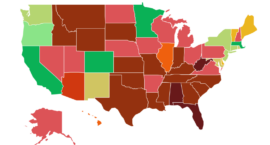In 2021, the Century Foundation published its first care policy report card, “Care Matters,” which graded each state on a number of supportive family policies and worker rights and protections, such as paid sick and paid family leave, pregnant worker fairness, and the domestic worker bill of rights. The 2021 report card revealed the tremendous gaps in state care policies and a fragmented and insufficient system of care workers and families in most states.
This year’s update, co-authored with Caring Across Generations, takes another look at how states are doing.





